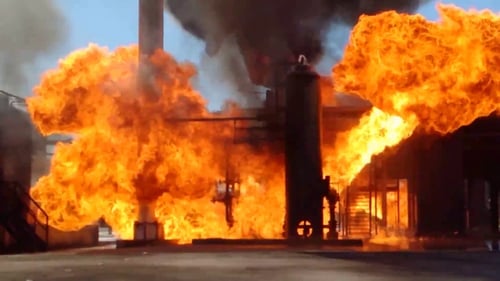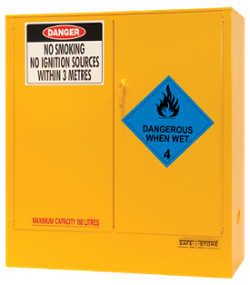As the name suggests, dangerous when wet substances can react violently with water, causing harm to staff, property and the surrounding environment. As a division of Class 4 dangerous goods, these chemicals must be handled and stored in a way that reduces risk.
In this post, we look at this dangerous goods division and highlight key considerations that you need to make if you’re carrying dangerous when wet substances at your worksite.
Examples of Dangerous When Wet Substances
Dangerous when wet chemicals are used for a variety of applications across industries such as mining and manufacturing.
Some common examples of Class 4.3 Dangerous When Wet substances include:
- Aluminium phosphide
- Calcium
- Calcium carbide
- Potassium
- Sodium
- Zinc particles
How are they Classified?
Dangerous when wet substances fall under Class 4 dangerous goods. These chemicals pose a unique set of properties and hazards for the organisations that handle and store them.
The ADG Code details the classification and division of all flammable solids:
Class 4: Flammable solids; substances liable to spontaneous combustion; substances which, on contact with water, emit flammable gases
- Division 4.1: Flammable solids, self-reactive substances solid desensitised explosives and polymerizing substances
- Division 4.2: Substances liable to spontaneous combustion
- Division 4.3: Substances which in contact with water emit flammable gases
Therefore, when working with dangerous when wet substances, you are dealing with Division 4.3 Dangerous Goods and the Australian Standard for Class 4 dangerous goods applies.
To further understand the classification of these chemicals, you can refer to Section 1.4.18 of the Australian Standard AS NZS 5026:2012 – The storage and handling of Class 4 dangerous goods.
The Standard explains the risks associated with dangerous when wet substances:
Division 4.3—Substances that, on contact with water, emit flammable gases
‘Dangerous when wet’ substances which, in contact with water, can emit flammable gases that can form explosive mixtures with air. Such mixtures are easily ignited by all ordinary ignition sources, e.g. naked lights, sparking hand tools, or unprotected light bulbs. The resulting blast wave and flames may endanger people and the environment.
NOTE: Emitted gases may also be toxic.
What are the Hazards Associated with Dangerous When Wet Substances?
If dangerous when wet substances come into contact with water, a violent reaction will occur. The reaction can create a range of hazards due to the flammable gases and toxic vapours that may be emitted. Flammable gases can create dangerous fires and explosions, while toxic gases can cause severe harm to human health, with the potential for fatalities.

Dangerous when wet substances can create fire or explosion hazards, with the potential for toxic gas emissions.
How Can You Reduce Risk with Division 4.3 Substances?
To protect your organisation, community and environment from the risk of fire and toxic gas emissions, dangerous when wet substances must be carefully handled and stored to minimise the likelihood of a reaction.
By following the requirements of the Australian Standard AS NZS 5026, you can create a safer workplace, as well as ensuring that your organisation is meeting its chemical compliance obligations.
Some key measures to reduce risk when dealing with Division 4.3 Dangerous When Wet substances in the workplace include:
- Ensuring dangerous goods segregation of incompatible substances
- Isolating ignition sources
- Implementing and maintaining compliant chemical storage
- Correct dangerous goods and hazard signage on packages, storage areas and at the premises
- Protecting substances from exposure to water
We’ll look at some of these key points in further detail below.
Segregation of Division 4.3 Chemicals
Segregation is the isolation of goods that are incompatible or can react dangerously. In a workplace situation where there are multiple divisions or classes of dangerous goods, this segregation can be achieved by implementing physical barriers, such as a compliant chemical storage cabinet.
It can also be achieved by maintaining set distances from incompatible substances within the same area.
It’s important to keep in mind that segregation distances apply to most classes of dangerous goods.
When looking specifically at the distances that apply to stores of packaged dangerous when wet substances, you must ensure that they are separated as per the following:
- Chemicals in closed containers: segregated by at least 5 metres
- Open containers: segregated by at least 8 metres
In addition to this, any dangerous when wet substances must be kept in separate compounds that don’t share a common drainage system.
Isolation of Ignition Sources
Stores of dangerous when wet substances must be separated from ignition sources. This is due to the chemical’s ability to produce flammable vapours, which may spark a fire or explosion.
Ignition sources may be static (such as a powerpoint or hot surface) or they may be introduced into the area by unsuspecting workers (ie. cigarette lighter or welding equipment).
When carrying any type of flammable substance, whether it’s a flammable liquid or a flammable solid, the identification and isolation of ignition sources is fundamental to site safety.
The Standard explains the requirements that relate to ignition sources and Class 4 substances:
(a) Where the Class 4 dangerous goods are kept in a fire-resistant storage cabinet, they shall be separated from any potential ignition source by at least 3 m.
(b) Where the Class 4 dangerous goods are capable of producing flammable gas, the requirements of AS/NZS 60079 series shall apply.
(c) All other stores of Class 4 dangerous goods shall be separated from any potential ignition sources by at least 8 m.
Therefore, if you’re storing your dangerous when wet substances in a compliant chemical storage cabinet, you need to ensure that there are no potential ignition sources within 3 metres of that store.
Compliant Dangerous When Wet Storage
With water reactivity a major risk, there are various types of stores that are suitable for Class 4 dangerous goods.
The Australian Standard explains that there are several types of stores including:
- Fire-resistant storage cabinet
- Room or area within a building, one wall of which is part of the external wall of the building
- Room or roofed area external to another building but attached to external wall of that building
- Free-standing, roofed building
However, due to the risks of storm damage and flooding, we recommend storing dangerous when wet substances in an indoor environment.
Our Class 4.3 cabinets provide the necessary controls to minimise risk with dangerous when wet substances.
These cabinet features include:
- Sequential door closing system to contain flammable vapours
- Self-closing, close fitting doors which automatically release if pressure builds up within the cabinet
- Perforated shelving for the free movement of air within the cabinet
- Liquid-tight spill containment system 150mm deep
- Double walled sheet steel construction, hermetically sealed
- 40mm thermic air barrier to provide a small window of time for evacuation and the use of firefighting equipment
- Flash arrestors and vent openings for the installation of mechanical ventilation systems to disperse vapours
Features of a STOREMASTA Class 4.3 cabinet include a thermic air barrier which provides protection in the event of a fire.
DID YOU KNOW Our range of Class 4.3 safety cabinets are hermetically sealed to prevent liquid or water vapour from entering the storage space. They are suitable for dangerous when wet substances in either liquid or solid form.
Division 4.3 Dangerous Goods and Hazard Signage
Any staff, contractors or visitors to your workplace must be able to immediately identify stores of dangerous goods. In the instance of dangerous when wet substances, there are two signs that must be visible.
Signage for Division 4.3 chemical storage includes:
- Dangerous When Wet 4 – dangerous goods diamond
- No Smoking, No Ignition Sources Within 3 Metres – hazard signage
 Dangerous goods label for dangerous when wet substances.
Dangerous goods label for dangerous when wet substances.
If you're storing your goods in a safety cabinet, the cabinet must also be marked with:
- Maximum storage capacity
- Name and address of the manufacturer / importer
To maintain compliance, all signs and marketing must be clearly visible when the doors are closed. If any signage goes missing or is damaged, then it must be replaced for the safety and compliance of your site.
REMEMBER: If the quantities of Class 4.3 substances at your site exceed the regulatory thresholds, then they should be placarded accordingly. See the Australian Standards for full placarding requirements.
Protection from Exposure to Water
This particular DG division requires protection from exposure to water at all times. Water can be in any form, including atmospheric moisture.
The key to achieving this is to ensure that the design, construction and operation of your store considers water protection. Emergency or non-routine scenarios must also be considered, in addition to your regular operations.
For example:
- Are your stores designed and constructed to prevent water entering from the ground level?
- Have you conducted a risk assessment to determine a safe location for your eyewash stations and emergency showers?
- Have you ensured that your spill response does not include water?
- Is your fire protection compatible or will it create further hazards?
Class 4 Safety
While these are just a few of the key considerations when storing dangerous when wet substances, there are many more. We strongly suggest you familiarise yourself with the Australian Standard, as well as the WHS laws that apply to your workplace. A risk assessment is also essential when carrying any type of dangerous goods — but it’s particularly important when your chemical class can react dangerously with other substances or water.
To make the risk assessment process easier, we’ve created a handy Chemical Risk Assessment Template Pack that you can use in your own organisation. It includes a hazardous substance register and risk assessment template that are straightforward and easy to use. Get your template pack for free today and help create a safer workplace.
Joining the team as a Dangerous Goods Storage Consultant, Melissa Hampton became Storemasta's Marketing Manager in late 2021. With extensive knowledge and experience in chemical compliance, Melissa is responsible for leading the Marketing team and helping shape their marketing strategy. In her spare time, you can find Melissa hiking, swimming and enjoying the great outdoors in beautiful north-west Tasmania.


